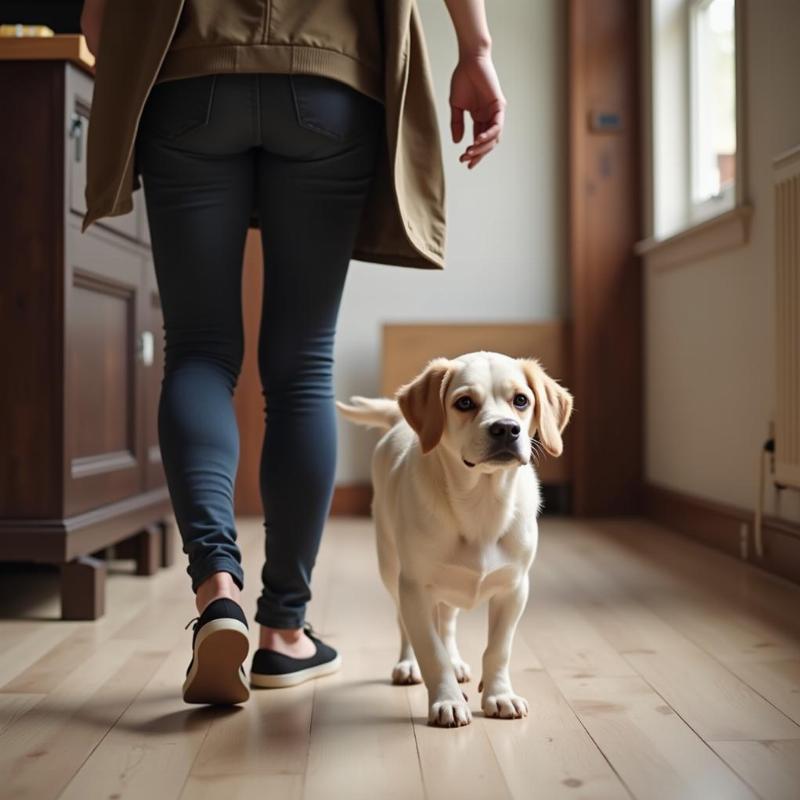Your furry friend follows you everywhere – bathroom breaks, kitchen trips, even to the mailbox. It’s sweet, sure, but sometimes that “dog won’t leave my side” behavior can be a bit much. This article will delve into the reasons why your dog might be exhibiting this clingy behavior and offer practical solutions for helping them become more independent, while still maintaining that loving bond you share.
Why is My Dog So Attached?
Several factors contribute to a dog’s clinginess. Understanding the root cause is key to addressing the behavior effectively. Is it breed specific? Some breeds, like Velcro dogs, are naturally more prone to sticking close to their humans. Or perhaps it’s due to underlying anxiety? Changes in routine, new environments, or even loud noises can trigger anxiety in dogs, leading them to seek comfort in their owner’s presence. Age can also play a role. Senior dogs can become more dependent due to cognitive decline or physical discomfort.
 Dog following owner
Dog following owner
Is it Separation Anxiety? Signs and Symptoms
While all clingy dogs aren’t necessarily suffering from separation anxiety, it’s important to recognize the signs. Destructive behavior when left alone, excessive barking or whining, and changes in eating habits can all point to this more serious issue. If you suspect your dog has separation anxiety, consult a veterinarian or certified professional dog trainer in the US for guidance and a tailored training plan. They can offer specialized advice and resources tailored to the American context and your dog’s specific needs.
Building Independence: A Step-by-Step Guide
Building your dog’s independence takes patience and consistency. Start by establishing a safe space, like a crate or dog bed, where your dog can feel secure. Associate this space with positive experiences by providing toys, treats, and praise. Gradually increase the time your dog spends in their safe space, rewarding them for calm behavior.
Short, regular periods of separation, even just stepping out of sight for a few minutes, can help your dog adjust to being alone. Remember to make your departures and arrivals low-key, avoiding excessive fuss. dog wont leave my side This reinforces the idea that being alone isn’t a big deal.
Enrichment and Exercise: Key to a Happy, Independent Dog
A tired dog is a well-behaved dog! Ensure your dog gets plenty of physical exercise and mental stimulation. Regular walks, playtime, and interactive toys can help reduce anxiety and promote independence. Consider puzzle toys or treat-dispensing balls to keep your dog occupied and entertained when you’re not around.
When to Seek Professional Help
If your dog’s clinginess is severe or accompanied by other behavioral issues, seeking professional help is crucial. dog won't stop barking when i leave A certified dog trainer or veterinarian experienced in behavioral issues can assess your dog’s behavior and create a personalized training plan. They can also rule out any underlying medical conditions that might be contributing to the clinginess.
Conclusion
A clingy dog can be a sign of a strong bond, but excessive attachment can hinder your dog’s well-being. ornamental grass safe for dogs By understanding the reasons behind your dog won’t leave my side behavior and implementing the strategies outlined in this article, you can help your furry friend become more confident and independent, while still enjoying a close and loving relationship. Remember, patience, consistency, and professional guidance, if needed, are key to success. pajamas with pictures of your dog
FAQ
- Is it normal for my dog to follow me everywhere? While some level of attachment is normal, excessive clinginess can indicate underlying anxiety or separation anxiety.
- How can I tell if my dog has separation anxiety? Signs include destructive behavior when left alone, excessive barking or whining, and changes in eating habits.
- What should I do if my dog won’t leave my side even when I’m home? Try establishing a safe space and gradually increasing the time your dog spends there.
- How much exercise does my dog need to reduce clinginess? The amount of exercise varies depending on breed and age, but aim for at least 30 minutes of daily activity.
- When should I contact a professional trainer? If your dog’s clinginess is severe, impacting their quality of life, or accompanied by other behavioral issues, it’s time to seek professional help.
- Can medication help with clinginess in dogs? In some cases, medication might be necessary, especially if the clinginess is related to anxiety. A veterinarian can determine if medication is appropriate. dog hotel for aggressive dogs
- What are some good resources for finding a certified dog trainer in the US? The American Kennel Club (AKC) and the Certification Council for Professional Dog Trainers (CCPDT) are excellent resources for finding qualified trainers.
Beautdogs.us is your premier online resource for comprehensive dog care information tailored to the American dog owner. From breed-specific advice to the latest in pet care trends, Beautdogs.us offers expert guidance for both novice and experienced dog owners. We offer a wide range of products and services to enhance the well-being of your canine companion. Connect with us today for personalized support! Email: [email protected], Phone: +1 501-555-7529. Visit Beautdogs.us for more information!